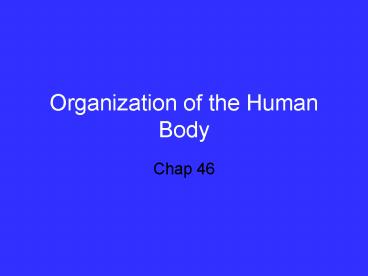Organization of the Human Body - PowerPoint PPT Presentation
1 / 37
Title:
Organization of the Human Body
Description:
Organization of the Human Body Chap 46 Flexors vs Extensors Flexor- pulls bone toward each other (flex) Extensors- pulls bones away from each other (extend) Work in ... – PowerPoint PPT presentation
Number of Views:189
Avg rating:3.0/5.0
Title: Organization of the Human Body
1
Organization of the Human Body
- Chap 46
2
Cell specialization
- Zygote
- Forms three germ layers
- Ectoderm outher layer, skin nervous system
- Mesoderm middle layer, muscles, bones and
connective tissue - Endoderm Inner layer, organs
3
Germ Layers
4
(No Transcript)
5
Cell specialization
- Tissue types
- Connective binds and supports other structures
(bones, elastins) - Function gives strength to softer tissues
- Origin mesoderm
6
Connective Tissue
7
Cell specialization (cont)
- Muscle
- Function movement
- Origin mesoderm
8
Muscle tissue
9
Cell specialization (cont)
- Nerve
- Function communication, coordination,
information - Origin ectoderm
- Types of nervous transmission
- Afferent sensory
- Efferent motor
10
Nerve Tissue
11
Afferent vs Efferent nerves
12
Tissues make organs
13
Organs make up Organ systems
14
Organ systems (cont)
15
Skeletal System
- Endoskeleton
- Advantages
- Flexible
- No molting
- Greatest support with least weight
- Disadvantages
- less protection than exo-
- Depend on nervous system for protection
16
- Skeleton Functions
- Support
- Muscle attachment
- Protection organs and CNS
- Store minerals
- Marrow storage
17
- Bone development
- Long bones
- Develop from cartilage Ossification
- Remove minerals from blood
- Calcium phosphate ions
- Calcium carbonate ions
- Continues throughout childhood
18
Long bones
19
Long bone Developement
20
- Bone development (cont)
- Flat bones cranium, sternum, jaw
- Develop from membrane layers
- Sutures joints in bones
- Bones not fused in baby allows brain to grow
21
Flatbones
22
Bone Structure
- Diaphysis shaft of bone
- Epiphysis ends of long bones
- Epiphyseal line growth line/plate
- Haversian system
- Haversian canal channels through bones
- Functions delivers blood to bone, nutrients,
osteocytes - Marrow
- Red
- Found flat bones, epiphyseal portion of long
bones - Function RBC, WBC (erythrocytes, leucocytes)
- Yellow
- Found central cavity of long bones (diaphysis)
- Function fat storage (in emergency may produce
RBCs
23
Bone Structure
24
Buffalo Humerus- Identify the parts of the long
bone
25
Joints
- Types
- Hinge elbow
- Ball and socket hip
- Angular wrist
- Gliding vertebrae
- Pivotal Atlas and Axis
- Top 2 vertebrae that allow head rotation
- Attachment
- Bone to bone ligaments
- Muscle to bone tendons
26
Ligaments and Tendons
27
Muscle systems
- Muscle tissue
- Made of cells that are able to shorten
28
Muscle fibers
- Fibers are single cells
- Energy provided by ATP (lots of mitochondria)
- Bundle of fibers is a motor unit
29
Muscle structure- made of may fibers
30
Muscle contraction videos
- http//www.youtube.com/watch?vCepeYFvqmk4
- http//www.youtube.com/watch?vNRzJjx3ANuE
31
(No Transcript)
32
Three Muscle types
(get notes from descriptions of pictures)
33
Identify these Muscle types
34
Flexors vs Extensors
- Flexor- pulls bone toward each other (flex)
- Extensors- pulls bones away from each other
(extend) - Work in opposites- each flexor has and extensor
to control the range of motion
35
Heart Contractions
- Sinoatrial node (pacemaker) in right atrium,
impulse start here and causes contraction - Atrioventricular node Causes ventricle
contraction - Atria contract, then ventricles, moves right to
left
36
Heart contractions
37
Electrocardiograms (EKG/ECG)
Figure 8.15B, C































